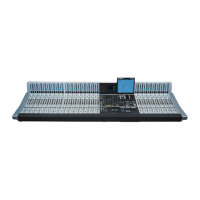D950 Digital Mixing System
6-26 System Administration SW V3.3 Date printed: 05.12.03
Monitoring & Talkback Configuration:
To configure a specific monitoring/talkback system, a second file has to be
created. This is the monitoring configuration file. There can be several
monitoring configuration files present in the system, but only one is used
at a time. The name of a monitoring configuration file is given by the user
and can, for example, be: MonMyStereo.ini (the prefix Mon is recommended,
and the extension *.ini is mandatory). The name of the currently valid con-
figuration file (with the full path) has to be specified in the D950system.ini
main initialization file within in the Windows directory. The D950system.ini
file will, in this case, contain the following record:
MonitoringIniFile=C:\D950SYSTEM\MonMyStereo.ini;
To explain the contents and use of the monitoring configuration, parts of a
typical configuration file are shown below. This is not a complete and
functional configuration file, but only parts that can serve as examples. For
the complete contents see the MonTemplate.ini file in C:\D950SYSTEM.
Signaling configuration: Signaling consists of different parts:
• Global red light,
• Signaling outputs, and
• Signaling inputs.
For the user-specific configuration of Global red light and Signaling out-
puts, there is an on-line editing tool which is part of the GC. The configu-
rations once made can be saved in and loaded from a specific signaling
file. Signaling inputs can currently only be configured in a special Signal-
ing.ini file.
First, let’s have a look at the definitions of global red light and signaling
out as they are defined in the D950:
Global red light Global red light controls the signal flow from an input to a master channel.
Valid input sources are AES In, MADI In and MicAD Mic sources.
The red light condition for a source is TRUE if any path from a source to a
master channel is open. This means in detail (also refer to the picture be-
low):
1. In case of a MicAD source, the MicAD selector is in the Mic position, and
the MicAD output is patched to a D950 patch source (AES or MADI);
2. The patch source is patched to an input, group, or master channel;
3. The input selector of the channel is in the right position, the channel is not
muted, and the fader is on. If the channel is not a master channel, it is as-
signed to a group bus (in case of an input channel) or master bus (input
and group channel);
4. If an input channel is assigned to a group bus, the input selector of the
group is in the right position, the group is not muted, the fader is on, and
the group output is assigned to a master bus;
5. The input selector of the master is in the right position, the master is not
muted, and the fader is on.

